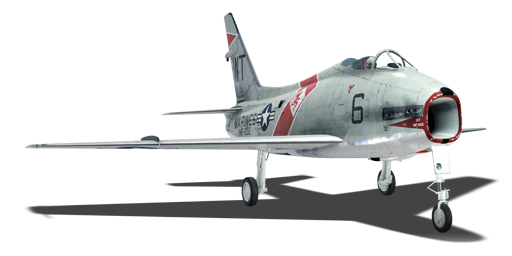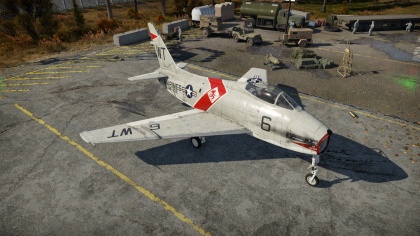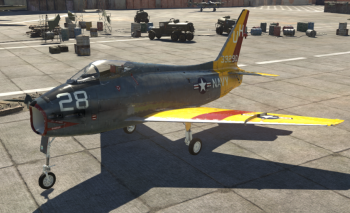Difference between revisions of "FJ-4B VMF-232"
(Edits.) |
(Added description.) |
||
| Line 18: | Line 18: | ||
{{break}} | {{break}} | ||
The '''{{Specs|name}}''' is a gift rank {{Specs|rank}} American jet fighter {{Battle-rating}}. It was introduced in [[Update 1.79 "Project X"]] as the main reward for the Good Old S.U.M.M.E.R event 2018. | The '''{{Specs|name}}''' is a gift rank {{Specs|rank}} American jet fighter {{Battle-rating}}. It was introduced in [[Update 1.79 "Project X"]] as the main reward for the Good Old S.U.M.M.E.R event 2018. | ||
| + | |||
| + | In the early 1950s, the US Navy realized during the Korean War that their straight-wing fighters were vastly inferior to the swept-wing [[MiG-15 (Family)|MiG 15s]] they flew against. Though the F7U and F9F fighters were under development, they were not ready for deployment requiring the Navy to look elsewhere for a usable swept-wing fighter. They looked to the Air Force’s [[F-86 (Family)|F-86]] Sabre as a stop-gap measure. Modifications were needed to make it aircraft carrier ready to include a stronger nose-wheel strut, all-moving flying tail without dihedral, outer wing panels folded upward and the windscreen was modified to aid the pilot’s visibility on approach for landing on the carrier. This version of the aircraft was designated as the FJ-2 Fury (completely different aircraft from the original North American FJ-1). Even with modifications, the aircraft was unfit for carrier duty and was passed onto the US Marines for land-based duty. | ||
| + | |||
| + | The FJ-3 underwent development to rectify issues the FJ-2 had. Now outfitted with a more powerful engine, wing shape changed to provide more manoeuvrability and eliminated the leading edge slats and were reinforced to allow for four external pylons to allow for external fuel tanks, 500 or 1,000 lb bombs. The fuselage was enlarged to allow for more airflow to reach the engine and the fighter was outfitted with AIM-9 Sidewinder air-to-air missiles. | ||
| + | |||
| + | The FJ-4 was a more aggressive approach compared to the FJ-3 with a much thinner wing and skin which was milled from solid alloy plates allowing for more strength, durability and aerodynamics. As the FJ-4 was built to be an all-weather interceptor, it required a considerable amount of fuel for operations and ultimately contained 50% more fuel than the FJ-3. To help conserve fuel, all of the protective armour was removed and the total ammunition count was reduced. Since weight was removed, an additional fuel tank was fitted within the fuselage, causing the “razorback” look to the rear deck of the aircraft just aft of the cockpit. Also, due to the stronger wing of this fighter, a total of six underwing stations were available allowing for more ordnance to be carried. | ||
| + | |||
| + | The {{PAGENAME}} found in War Thunder is a solid multi-role US Marine aircraft which can fight air-to-air combat, ground-pound or both. The fighter features four 20 mm autocannons and then can outfit several different ordnance to its underwing stores. Bomb load-outs range from using 250, 500, 1,000 or 2,000 lb bombs effectively targeting from vehicles and pillboxes all the way up to bases. FFAR Mighty Mouse rockets make short work of ground targets, but also can be deadly against any of the bomber aircraft it may intercept. Bullpup rockets can create a huge punch into a ground target, however, it requires the attention of the pilot all the way to the target to ensure it hits. The {{PAGENAME}} can also sport either two or four AIM-9B Sidewinder missiles, which any smart pilot on the receiving end will immediately begin evasive manoeuvres when one of these are inbound because, at that point, nothing else matters! | ||
== General info == | == General info == | ||
Revision as of 14:35, 7 October 2019
Contents
| This page is about the gift jet fighter FJ-4B VMF-232. For the regular version, see FJ-4B. For other uses, see Fury (Disambiguation). |
Description
The FJ-4B VMF-232 Fury is a gift rank VI American jet fighter
with a battle rating of 9.0 (AB/SB) and 8.7 (RB). It was introduced in Update 1.79 "Project X" as the main reward for the Good Old S.U.M.M.E.R event 2018.
In the early 1950s, the US Navy realized during the Korean War that their straight-wing fighters were vastly inferior to the swept-wing MiG 15s they flew against. Though the F7U and F9F fighters were under development, they were not ready for deployment requiring the Navy to look elsewhere for a usable swept-wing fighter. They looked to the Air Force’s F-86 Sabre as a stop-gap measure. Modifications were needed to make it aircraft carrier ready to include a stronger nose-wheel strut, all-moving flying tail without dihedral, outer wing panels folded upward and the windscreen was modified to aid the pilot’s visibility on approach for landing on the carrier. This version of the aircraft was designated as the FJ-2 Fury (completely different aircraft from the original North American FJ-1). Even with modifications, the aircraft was unfit for carrier duty and was passed onto the US Marines for land-based duty.
The FJ-3 underwent development to rectify issues the FJ-2 had. Now outfitted with a more powerful engine, wing shape changed to provide more manoeuvrability and eliminated the leading edge slats and were reinforced to allow for four external pylons to allow for external fuel tanks, 500 or 1,000 lb bombs. The fuselage was enlarged to allow for more airflow to reach the engine and the fighter was outfitted with AIM-9 Sidewinder air-to-air missiles.
The FJ-4 was a more aggressive approach compared to the FJ-3 with a much thinner wing and skin which was milled from solid alloy plates allowing for more strength, durability and aerodynamics. As the FJ-4 was built to be an all-weather interceptor, it required a considerable amount of fuel for operations and ultimately contained 50% more fuel than the FJ-3. To help conserve fuel, all of the protective armour was removed and the total ammunition count was reduced. Since weight was removed, an additional fuel tank was fitted within the fuselage, causing the “razorback” look to the rear deck of the aircraft just aft of the cockpit. Also, due to the stronger wing of this fighter, a total of six underwing stations were available allowing for more ordnance to be carried.
The FJ-4B VMF-232 found in War Thunder is a solid multi-role US Marine aircraft which can fight air-to-air combat, ground-pound or both. The fighter features four 20 mm autocannons and then can outfit several different ordnance to its underwing stores. Bomb load-outs range from using 250, 500, 1,000 or 2,000 lb bombs effectively targeting from vehicles and pillboxes all the way up to bases. FFAR Mighty Mouse rockets make short work of ground targets, but also can be deadly against any of the bomber aircraft it may intercept. Bullpup rockets can create a huge punch into a ground target, however, it requires the attention of the pilot all the way to the target to ensure it hits. The FJ-4B VMF-232 can also sport either two or four AIM-9B Sidewinder missiles, which any smart pilot on the receiving end will immediately begin evasive manoeuvres when one of these are inbound because, at that point, nothing else matters!
General info
Flight Performance
Describe how the aircraft behaves in the air. Speed, manoeuvrability, acceleration and allowable loads - these are the most important characteristics of the vehicle.
| Characteristics | |||||||
|---|---|---|---|---|---|---|---|
| Stock | |||||||
| Max Speed (km/h at 152 m) |
Max altitude (meters) |
Turn time (seconds) |
Rate of climb (meters/second) |
Take-off run (meters) | |||
| AB | RB | AB | RB | AB | RB | ||
| 1,058 | 1,029 | 14700 | 32.5 | 33.3 | 28.1 | 26.4 | 750 |
| Upgraded | |||||||
| Max Speed (km/h at 152 m) |
Max altitude (meters) |
Turn time (seconds) |
Rate of climb (meters/second) |
Take-off run (meters) | |||
| AB | RB | AB | RB | AB | RB | ||
| ??? | 1090 | 14700 | ??.? | 31 | ??.? | 35 | 750 |
Details
| Features | ||||
|---|---|---|---|---|
| Combat flaps | Take-off flaps | Landing flaps | Air brakes | Arrestor gear |
| ✓ | ✓ | ✓ | ✓ | ✓ |
| Limits | ||||
|---|---|---|---|---|
| Wing-break speed (km/h) |
Gear limit (km/h) |
Combat flaps (km/h) |
Max Static G | |
| + | - | |||
| 620 | ~10 | ~4 | ||
| Optimal velocities | |||
|---|---|---|---|
| Ailerons (km/h) |
Rudder (km/h) |
Elevators (km/h) |
Radiator (km/h) |
| < 750 | < 690 | < 680 | N/A |
| Compressor (RB/SB) | ||
|---|---|---|
| Setting 1 | ||
| Optimal altitude | 100% Engine power | WEP Engine power |
| 152 m | 3,410 kgf | N/A |
Survivability and armour
Examine the survivability of the aircraft. Note how vulnerable the structure is and how secure the pilot is, whether the fuel tanks are armoured, etc. Describe the armour, if there is any, and also mention the vulnerability of other critical aircraft systems.
Armaments
Offensive armament
The FJ-4B VMF-232 is armed with:
- 4 x 20 mm Browning-Colt Mk12 Mod 3 cannons, nose-mounted (144 rpg = 576 total)
Suspended armament
The FJ-4B VMF-232 can be outfitted with the following ordnance:
- Without load
- 6 x 250 lb LDGP Mk 81 bombs (1,500 lb total)
- 6 x 500 lb LDGP Mk 82 bombs (3,000 lb total)
- 2 x 1,000 lb LDGP Mk 83 bombs (2,000 lb total)
- 2 x 1,000 lb LDGP Mk 83 bombs + 4 x 500 lb LDGP Mk 82 bombs (4,000 lb total)
- 2 x 2,000 lb LDGP Mk 84 bombs (4,000 lb total)
- 114 x FFAR Mighty Mouse rockets
- 2 x AIM-9B missiles + 76 x FFAR Mighty Mouse rockets
- 5 x AGM-12B Bullpup missiles
- 2 x AIM-9B missiles
- 4 x 250 lb LDGP Mk 81 bombs + 2 x AIM-9B missiles (1,000 lb total)
- 4 x 500 lb LDGP Mk 82 bombs + 2 x AIM-9B missiles (2,000 lb total)
- 2 x 1,000 lb LDGP Mk 83 bombs + 2 x 500 lb LDGP Mk 82 bombs + 2 x AIM-9B missiles (3,000 lb total)
Usage in battles
Describe the tactics of playing in an aircraft, the features of using vehicles in a team and advice on tactics. Refrain from creating a "guide" - do not impose a single point of view, but instead, give the reader food for thought. Examine the most dangerous enemies and give recommendations on fighting them. If necessary, note the specifics of the game in different modes (AB, RB, SB).
Manual Engine Control
| MEC elements | ||||||
|---|---|---|---|---|---|---|
| Mixer | Pitch | Radiator | Supercharger | Turbocharger | ||
| Oil | Water | Type | ||||
| Not controllable | Not controllable Not auto controlled |
Not controllable Not auto controlled |
Not controllable Not auto controlled |
Combined | Not controllable 1 gear |
Not controllable |
Modules
| Tier | Flight performance | Survivability | Weaponry | |||
|---|---|---|---|---|---|---|
| I | Fuselage repair | Compressor | Offensive 20 mm | FSBC mk.5 | ||
| II | New boosters | Airframe | SBC mk.1 | AERO 7D | ||
| III | Wings repair | Engine | New 20 mm cannons | MBC mk.1 | AGM-12B Bullpup | |
| IV | G-suit | Cover | LBC mk.1 | AIM-9B | ||
Pros and cons
Pros:
- Relatively high top speed
- Powerful fast firing cannons and payload options
- Superb ground attack potential
- Has AGM-12B Bullpups air-to-ground missiles
- Can land on carriers with ease
- Can equip 2 x AIM-9B air-to-air missiles along with bombs
Cons:
- Very inaccurate guns when stock
- Slow acceleration (especially when stock)
- Carrying ordinance significantly reduces performance
- Is not competitive against pure jet fighters
History
The FJ-4 was the fourth modification of the Fury - the naval version of the F-86 Sabre, serving primarily with the USMC. Being initially conceived as an all-weather interceptor, the FJ-4 Fury had to incorporate several design changes compared to the previous fighter version in order to fulfill this new role. The most notable change was the increase in range and the installation of new, thinner wing with an increased surface area. To achieve the range increase, the aircraft underwent several structural changes which reduced its weight and allowed for additional fuel tanks to be installed. Additionally, a more powerful Wright J65-W-16A engine, producing 7,700 lbf of thrust, was installed on the production versions. Following successful test flights, production of the FJ-4 commenced in 1955 with first units entering service with the Navy in 1956. Over 150 FJ-4 Fury interceptors were built.
Wishing to increase the strike capabilities of the new FJ-4, engineers of the North American company went back to the drawing board and once more applied several changes to the design, creating the FJ-4B. The FJ-4B version most notably featured a strengthened wing, offering an increased payload by adding two additional hardpoints to each wing, bringing the total up from two to six. Furthermore, the aircraft received air brakes under the aft of the fuselage, making dive bombing and landing easier. Of the original order for 221 FJ-4 Fury interceptors, the last 71 were modified into the FJ-4B fighter-bomber version. An additional order for 151 FJ-4B Furies followed in April 1956, bring the total of produced FJ-4Bs up to 222. Both the interceptor and fighter-bomber version of the FJ-4 served with the Navy and USMC until the early 1960s, before being phased out of active service and moved to the Naval Air Reserve. The FJ-4 was the last modification of the Fury and among the last mass-produced variants of the Sabre lineage.
- From Devblog
Media
See also
Links to the articles on the War Thunder Wiki that you think will be useful for the reader, for example:
- reference to the series of the aircraft;
- links to approximate analogues of other nations and research trees.
External links
| USA jet aircraft | |
|---|---|
| Fighters | |
| F9F | F9F-2 · F9F-5 · F9F-8 |
| F-80 | F-80A-5 · F-80C-10 |
| F-84 | F-84B-26 · F-84F · F-84G-21-RE |
| F-86 | F-86A-5 · F-86F-25 · F-86F-2 · F-86F-35 |
| F-89 | F-89B · F-89D |
| F-100 | F-100D |
| F-104 | F-104A · F-104C |
| F-4 | F-4C Phantom II · F-4E Phantom II · F-4J Phantom II · F-4S Phantom II |
| F-5 | F-5A · F-5C · F-5E · F-20A |
| F-8 | F8U-2 · F-8E |
| F-14 | F-14A Early · ▄F-14A IRIAF · F-14B |
| F-15 | F-15A · F-15C MSIP II · F-15E |
| F-16 | F-16A · F-16A ADF · F-16C |
| Other | P-59A · F2H-2 · F3D-1 · F3H-2 · F4D-1 · F11F-1 |
| Strike Aircraft | |
| FJ-4 | FJ-4B · FJ-4B VMF-232 |
| A-4 | A-4B · A-4E Early |
| A-7 | A-7D · A-7E · A-7K |
| AV-8 | AV-8A · AV-8C · AV-8B Plus · AV-8B (NA) |
| A-10 | A-10A · A-10A Late · A-10C |
| F-111 | F-111A · F-111F |
| Other | A-6E TRAM · F-105D · F-117 |
| Bombers | |
| B-57 | B-57A · B-57B |






